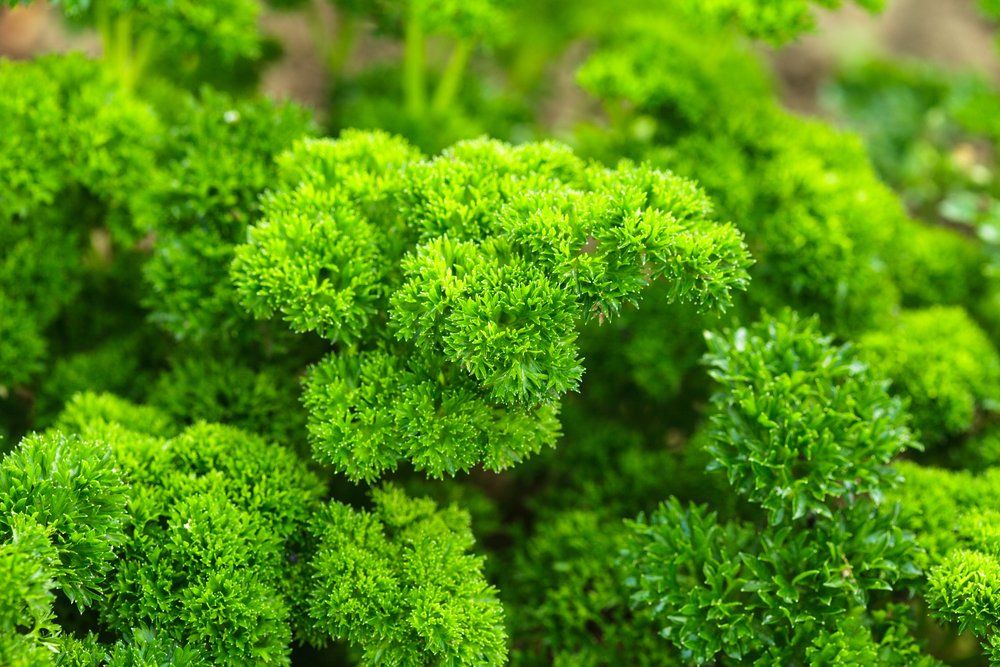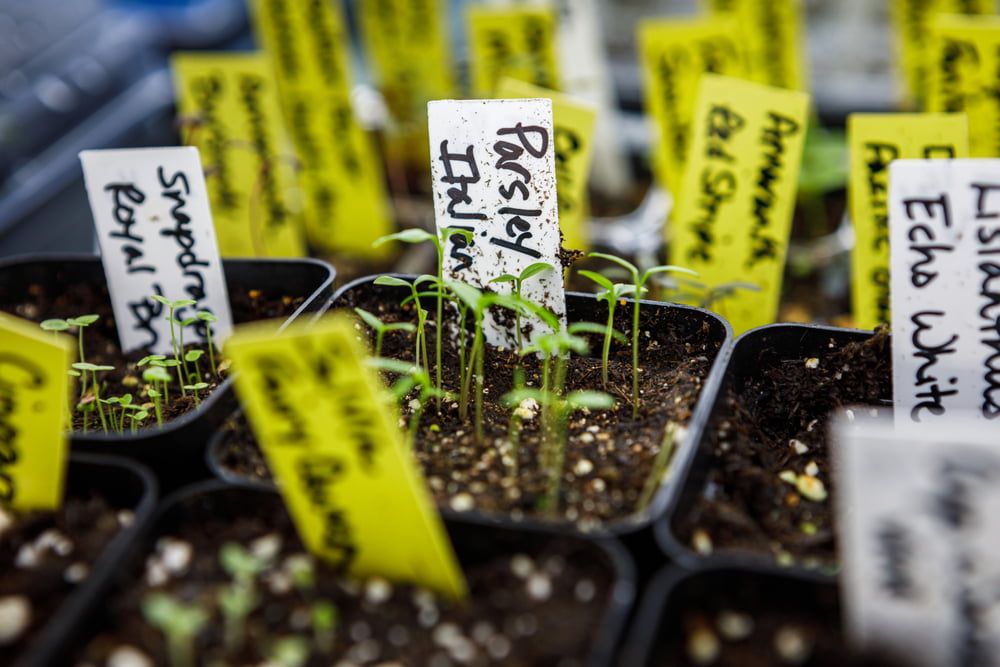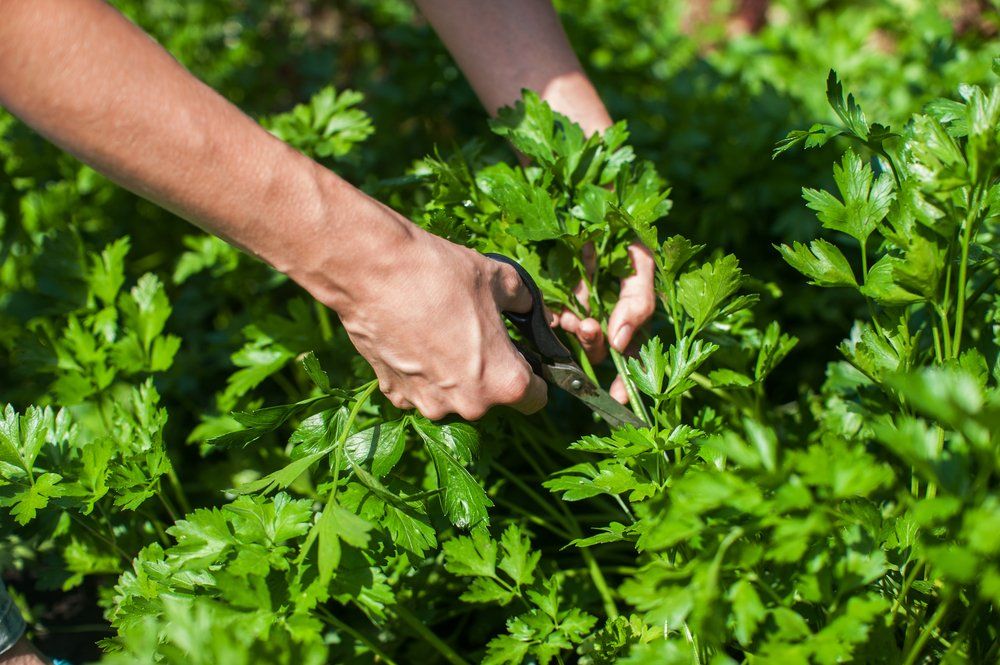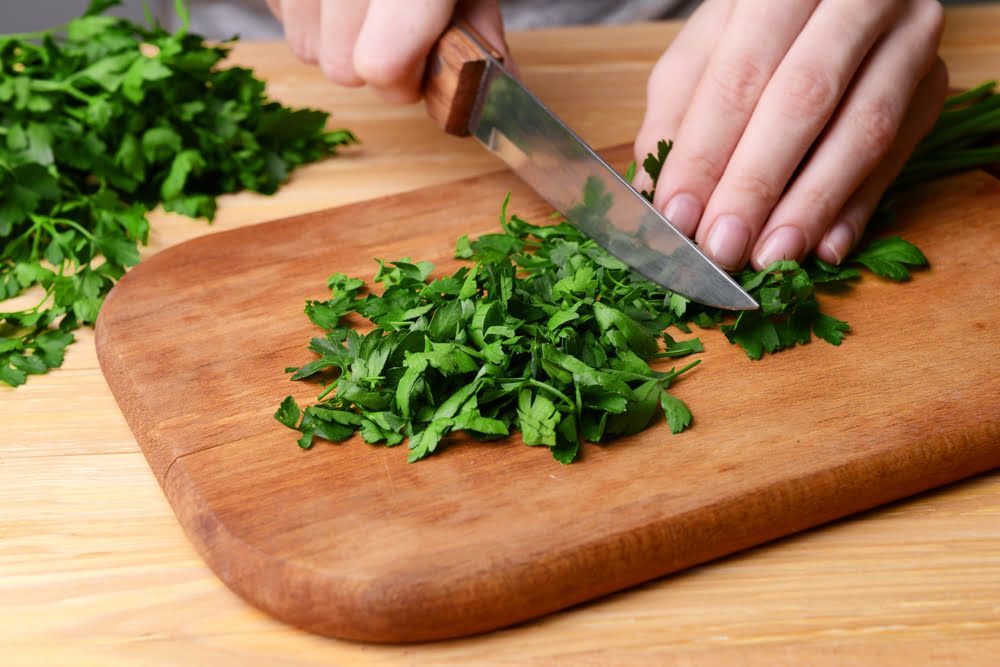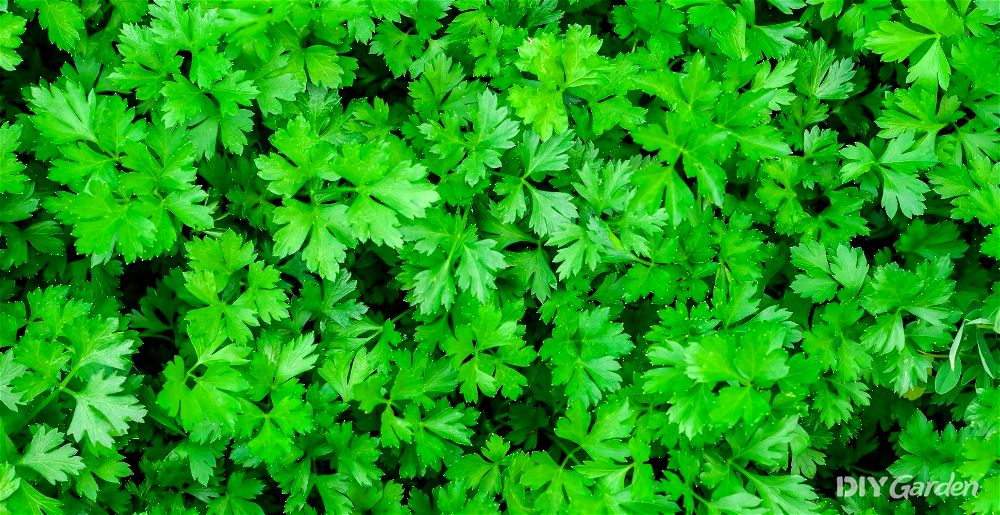
Although native to the Mediterranean, parsley’s adaptability allows it to tolerate a variety of climates, making it a key herb in cuisines from all over the world. If you’ve been looking for an easy way to improve the vitamin content, along with the flavour, of your meals, this low-maintenance, nutrient-packed biennial won’t let you down.
Growing Parsley: A Quick Snapshot
When to Sow – Mar-Jun
When to Plant – May-Jul
When to Harvest – Jun-Nov
Average Yield per Plant – 50-100g
Spacing – 15cm
Depth – 1cm
How to Grow Parsley at Home
Not only is parsley absolutely delicious when used fresh, but this herb is also so easy to grow and doesn’t take up much space in a garden. If you’re able to provide your parsley plants with the right growing conditions, then they’ll flower in their second year, with their blossoms being a popular choice among springtime pollinators.
Growing Requirements for Parsley
Parsley does best in either full sun or partial shade. If you live in an area that experiences very hot summers, then pick a location that offers some afternoon shade.
Parsley doesn’t need much space above the ground, but its long taproot, which then produces secondary roots, does best in a deep and rich soil. This should also ideally be moisture-retentive but well-draining – a combination that can be tricky to achieve!
That being said, parsley is adaptable, but you always have the option of growing it in pots so that you can put together the perfect soil mix. This also means that you’ll be able to bring your parsley indoors over the winter, which will allow you to harvest from your plants almost all year round!
Companion Planting with Parsley
Since you won’t need too many parsley plants for one household (aim for two plants per person for eating fresh, or ten per person for preserving), most gardeners don’t usually have a dedicated parsley bed. Instead, they choose to grow the herb in amongst the other plants in their vegetable garden, with parsley being extremely useful at repelling the pests that would have otherwise troubled those plants.
Some of the best companion plants for parsley are:
How to Grow Parsley from Seed
Although parsley will germinate when sown directly outside, germination rates are long and erratic. To give your plants the best start possible, it’s worth starting your seeds off indoors.
Since parsley seeds are so tiny, making them near-impossible to sow thinly, start your seeds off in small pots. Fill the pots with a multi-purpose compost and water well. Then, lightly sprinkle your seeds over the surface of the soil, as thinly as you can. Cover over with a very light layer of compost (parsley seeds don’t need to be buried more than 1cm deep), and lightly water again.
Parsley has been known to germinate at temperatures as low as 5°C and as high as 32°C. However, both extremes result in poor germination, so aim to keep your seeds at around 20-27°C for best results.
After that, you’ll need to be patient. It can take parsley seeds up to six weeks to germinate, so make sure that you keep your pots moist throughout this time.
Once seedlings appear, make sure that they have plenty of light. Wait until they have produced their second set of true leaves before thinning them out, leaving just one or two of the healthiest seedlings in each pot.
How to Plant Parsley Outside
Established parsley plants can tolerate temperatures down to -12°C, but young plants aren’t quite so cold-hardy. So, wait until your last frost of the spring has passed before planting your parsley outside.
Prepare your growing area by thoroughly weeding it. Make sure that your soil is deep enough for those 15cm taproots to delve down, adding in some extra compost if necessary.
Then, dig holes in your soil that are the same size as the pots that your parsley plants are in. Space each hole about 15cm apart, but double-check the recommended spacing for your variety too. Dwarf parsley varieties will manage fine with less space, whereas larger varieties may need more.
Gently remove your parsley plants from their pot, trying to keep the soil and rootball as intact as possible. Place each plant into a hole and cover back over with soil, before firming the soil down. Water your plants well after planting – this will help to reduce any air pockets in the soil and encourage faster root establishment.
How to Plant Parsley in a Greenhouse
Parsley grows well in a greenhouse. The plants mature faster and are also more likely to stick around in the winter, giving you a much longer harvesting period.
The planting methods for growing parsley in a greenhouse are the same as when planting outside. The only difference is that you’ll be able to move your plants into their final location earlier in the season, before your spring frosts have ended.
Since a greenhouse offers a protected growing environment, you could also try direct sowing your parsley seeds into your greenhouse beds.
How to Care for Parsley
If you’ve provided the right growing conditions, then your parsley won’t need too much attention after being planted. The main areas to focus on are as follows:
Watering Parsley
Parsley needs around 3-5cm of water a week. If your plants run too dry, they’ll start to wilt. This not only affects the flavour of the leaves, but also inhibits growth, affecting your overall harvest.
If the weather has been dry, aim to deeply water your parsley about twice a week. You’ll need to water more often if your plants are growing in a greenhouse.
Feeding Parsley
Parsley is a heavy feeder. Even if your plants are growing in rich soil, they would still benefit from some fertiliser a couple of times during their growing season. An organic, slow-release fertiliser, such as blood, fish, and bone, is perfect for parsley.
Weeding and Mulching Parsley
Once established, your parsley will likely outperform any weeds growing around it. However, in order for it to actually get to that stage, you’ll need to keep your growing area weed-free.
Be careful when weeding around your plants – you don’t want to accidentally disturb their roots. One way to cut back on the amount of weeding needed is to lay a mulch around your parsley plants. This will also help to keep soil moisture and temperature consistent, which will prolong your harvesting period.
How to Harvest Parsley
Once you notice that the stems on your parsley plants have three leaf segments, they’re ready to be picked. Simply snip away the stems as needed, cutting them at their base. Try to choose outer stems – these will be older, and cutting them away then allows the younger inner stems to mature faster.
It’s advisable to harvest your parsley plants in the mornings, rather than later in the day. This is when their oils are at their strongest, meaning a more intense flavour.
The more you harvest your parsley, the more leaves it will produce. Frequent pickings will also help to delay bolting, which will extend your harvesting period.
How to Store Parsley
There’s nothing quite like fresh parsley, but if you’ve picked more than you can eat in one day, you’ll need to look into storage options. Fortunately, there are a few to choose from:
- Fill a jar with water and place your parsley stems into this, making sure that the leaves aren’t touching the water. Not only will this keep your parsley fresh for several weeks (so long as you keep the water at room temperature and replace it every couple of days), but the stems may also produce new leaves
- Wrap the parsley in a damp paper towel and then place this into an airtight bag. You can then store this in the fridge for up to five days
- Frozen parsley will retain its flavour for about six months. Just wash and dry the leaves and stems, chop them up, and then place them into a bag or container before freezing
- Parsley can be dried and then ground up, after which it will store for a couple of years. However, the drying process really takes away a large amount of the herb’s flavour, making freezing the best option for long-term storage
How to Prepare & Cook Parsley
There’s not much preparation involved for fresh parsley. Both the leaves and the stems can be eaten – just give them a wash and they’re ready to go.
Since the stems are tougher than the leaves, they can be added to dishes earlier on in the cooking process. You may also want to chop these up finer than you do the leaves.
Parsley can be used as a garnish on just about everything. However, if you’re looking for some dishes that truly showcase the herb as a main ingredient, a few options would be:
- A chimichurri sauce
- Parsley and watercress soup
- A Middle-Eastern Tabbouleh salad
- Parsley pesto
- Gremolata
Compared to many other herbs, parsley holds up well to the heat from cooking. However, try to eat it raw as much as possible too. This herb is brimming with vitamins A, C, and K, and can help with everything from bone health to chronic diseases.
Common Parsley Problems
Parsley isn’t usually susceptible to many problems, which is why it’s such an easy plant to grow. However, just in case you’re unlucky, some of the issues that you should know about are:
- Carrot fly – unfortunately, there’s not much that you can do once the larvae of these pests start to attack your parsley roots. However, mesh your plants the following year to prevent them from striking again
- Root rot – this disease occurs when the soil is too damp. It causes leaves to turn yellow and stems to turn brown, after which the rest of the plant starts discolouring and dying. Remove any infected plants and make sure that you improve drainage before trying to grow parsley or anything else from the carrot family in that soil again
- Leaf spot – this fungus is usually splashed onto plants with water, so try keeping your parsley foliage dry. You’ll notice yellow spots that soon turn brown, with the rest of the plant suffering too. Remove any infected plant parts and consider applying an organic sulfur treatment
Popular Parsley Varieties to Grow
Parsley varieties are usually categorised as being either flat-leaf or curly-leaf. While curly-leaf parsley definitely looks more impressive as a garnish, flat-leaf parsley tends to be more flavourful, and is also easier to prep in the kitchen.
That being said, one variety that doesn’t fall into the following two categories is Hamburg Parsley. This variety is grown for its large and thick roots, with its leaves being more ornamental.
Best Flat-Leaf Parsley Varieties:
- Gigante Napoletano – has leaves that are exceptionally large yet highly aromatic
- French – one of the most favoured varieties for cooking with
- Titan – although these leaves are small, they have a sweetness to them that other varieties lack
Best Curly-Leaf Parsley Varieties:
- Aphrodite – these dark green leaves are curled very tightly, and have a great flavour too
- Extra Curled Dwarf – beautifully curled leaves and a plant that has a compact growing habit, making it great for containers
- Moss Curled – a bushy plant that produces very dense rosettes of aromatic leaves
Conclusion
Not only does parsley give you a steady supply of flavourful leaves to harvest for at least half of the year, but its flowers will also bring a regular stream of pollinators to your garden. This easy-to-grow herb also happens to be very good for you, and there’s no easier way to start eating more of it than by having your own parsley plants growing at home!
